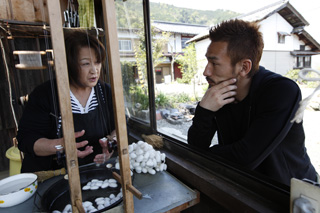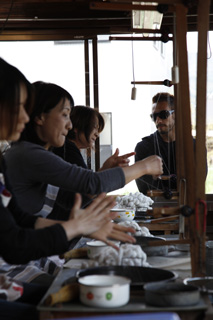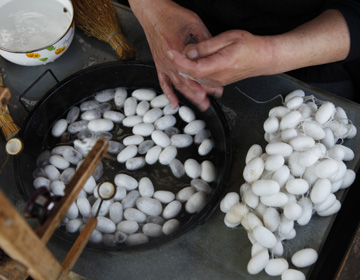Passing on tradition, picking thread at the workshop
The meadows stretch out at Kinomoto-cho Ooto, an area abundant with nature. We heard a soft clinking sound as we approached the workshop owned by Mieko Tsukuda. It was the sound of weaving thread. This sound has not changed from 1000 years ago from the Heian period. This is ”home to raw silk,” a long stretch of land surrounding Yogo Lake, north of Shizugatake, which has been the stage for the novel written by Tsutomu Mizukami. Long ago, spinning thread out of silk used to be a part time job during the agricultural off-season, and women of all families used to spin thread from silk. However, the number of people performing this task decreased during the Meiji period, and currently the only studio left belongs to Ms. Tsukuda.

Drawing thread from the cocoon
The thread is drawn with a piece of straw after the cocoon is heated to about 80℃ to make it soft. This is done sitting in front of a machine called a ”zaguriki”. This procedure requires much concentration and patience. Tsukuda explains how it has always been an abhorred job.
However, it is one that has value. In 1991, Ms. Tsukuda founded the ””Kinomoto Association for Silk Thread for Strings of Traditional Japanese Musical Instruments” to be able to pass on this traditional technique. Currently, 9 women have joined to succeed this tradition on to the next generation.
The raw thread that is spun is brought to ”Marusan Hashimoto” to be made into strings for Japanese instruments. The clicking sound of the thread being spun, is then spun into Japanese sounds.





